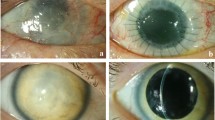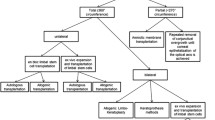Summary
Background
To present results of development and study of the keratoprosthesis method used at the Filatov Institute of Eye Diseases and Tissue Therapy since 1966.
Materials and methods
A retrospective case series analysis is used to describe the development of new types of keratoprostheses and methods of implantation as well as different ways of leukoma strengthening.
Results
Keratoprosthesis was performed in 1060 eyes of 1040 patients with leukomas of different etiology: burns, 725 eyes (68.4 %); trauma, 120 eyes (11.3 %); keratitis, Stevens–Johnson syndrome and ocular pemphigoid, 108 eyes (10.2 %); and aphakic/pseudophakic keratopathy, 107 eyes (10.1 %). Visual acuity before keratoprosthesis consisted of light perception in 962 eyes (92 %), and 98 eyes (8 %) had minimal visual acuity (1/200–1/50). Both eyes were blind (visual acuity less than 1/200) in 955 patients (91.8 %). The period of blindness varied from 1 to 52 years. As a result of keratoprosthesis, visual acuity of ≥ 1/200 was restored in 1023 of 1060 eyes (96.5 %). Visual acuity of 20/200–20/20 was achieved in 716 eyes (67.5 %). At the last follow-up visit, visual acuity of ≥ 1/200 was preserved in 806 eyes (76 %), visual acuity of 20/200–20/20 was measured in 583 of 1060 eyes (55 %), and good keratoprosthesis fixation in the cornea was achieved in 986 of 1060 eyes (93 %). The minimal follow-up was 12 months (range: 12 months to 37 years, median: 5 years).
Conclusion
Our techniques of keratoprosthesis effectively restore vision in patients with leukomas that cannot be treated by optical corneal grafting.
Zusammenfassung
Zielsetzung
Ziel des vorliegenden Beitrags ist es, die Ergebnisse der Entwicklung und Untersuchung der Keratoprothetik, wie sie seit 1966 am Filatov Institut für Augenkrankheiten und Gewebetherapie im Einsatz steht, zu präsentieren.
Material und Methode
Mittels retrospektiver Fallserienanalyse wird die Entwicklung neuer Typen der Keratoprothese und Implantationsmethoden sowie unterschiedliche Weisen der Leukombehandlung dargestellt.
Resultate
Keratoprothesen wurden bei 1040 Patienten (1060 Augen) mit Leukomen unterschiedlicher Ätiologie eingesetzt: Verbrennungen: 725 Augen (68,4 %); Traumata: 120 Augen (11,3 %); Keratitis, Stevens-Johnson- Syndrom und okuläres Pemphigoid: 108 Augen (10,2 %); sowie aphakische/pseudophakische Keratopathie: 107 Augen (10,1 %). Bei 962 Augen (92 %) beschränkte sich die Sehschärfe vor Keratoprothetik auf die Lichtwahrnehmung; bei 98 Augen (8 %) lag eine verminderte Sehschärfe vor (1/200–1/50). Bei 955 Patienten (91,8 %) waren beide Augen blind (Sehschärfe weniger als 1/200). Die Dauer der Blindheit schwankte zwischen 1 und 52 Jahren. Als Ergebnis der Keratoprothetik wurde bei 1023 der 1060 Augen (96,5 %) die Sehschärfe auf ≥ 1/200 wiederhergestellt und bei 716 Augen (67,5 %) auf 20/200–20/20. Bei der letzten Nachbeobachtung wurde bei 806 Augen (76 %) eine Sehschärfe ≥ 1/200 erhalten, bei 583 aus 1060 Augen (55 %) wurde eine Sehschärfe von 20/200–20/20 gemessen, und bei 986 von 1060 Augen (93 %) wurde eine angemessene Fixierung der Keratoprothese in der Hornhaut erzielt. Die kürzeste Nachbeobachtung betrug 12 Monate (Intervall: 12 Monate bis 37 Jahre; median: 5 Jahre).
Schlussfolgerung
Mit unseren Techniken der Keratoprothetik kann die Sehkraft bei Patienten mit Leukomen, die sich einer optischen Keratoplastik entziehen, effektiv wiederhergestellt werden.








Similar content being viewed by others
References
Cardona H, De Voe A. Prosthokeratoplasty. Trans Am Acad Ophthalmol Otolaryngol. 1977;83(2):271–80.
Castroviejo R, Cardona H, De Voe A. Present status of prosthokeratoplasty. Am J Ophthalmol. 1969;68(4):613–25.
Gomaa A, Comyn O, Liu C. Keratoprostheses in clinical practice—a review. Clin Exp Ophthalmol. 2010;38(2):211–24.
Liu C, Paul B, Tandon R, et al. The osteo-odonto-keratoprosthesis (OOKP). Semin Ophthalmol. 2005;20(2):113–28.
Aquavella JV, Qian Y, McCormick GJ, Palakuru JR. Keratoprosthesis: the Dohlman-Doane device. Am J Ophthalmol. 2005;140:1032–8.
Puchkovskaya NA, Yakimenko SA. Optical keratoprosthesing. Kiev: Zdorov’e; 1986.
Yakimenko SA. Keratoprosthesis in treatment of terminal stages of edematous bullous keratopathy. Annals del Instituto Barraquer. 2001;30(1–2):87–8.
Yakimenko SA. Surgical treatment of secondary glaucoma in patients with keratoprostheses. Annals del Instituto Barraquer. 2002;31(2):163.
Iakymenko SA. Keratoprosthesis: 40-years experience of study and application in the Filatov Institute (analysis of 1000 operations). In: Lang GK, editor. World Ophthalmology Congress (abstracts). Berlin: Media Service GmbH; 2010. p. 41.
Puchkovskaia NA, Iakimenko SA, Golubenko EA. Personal experience with keratoprosthesis. Oftalmol Zh. 1975;30(7):490–5.
Puchkovskaia NA, Iakimenko SA. Penetrating keratoprosthesis insertion in leucoma using improved models of keratoprostheses and surgical technique of their insertion. Klin Oczna. 1981;83(2):105–7.
Puchkovskaya NA, Muchnik SR, Golubenko EA. Corneal alloplasty. Oftalmol Zh. 1970;25(4):247–52.
Iakimenko SA. Methods for optical keratoprosthesis, the indications, potentials and results of their use. Oftalmol Zh. 1985;3:134–7.
Iakimenko SA. Optic penetrating keratoprosthesis using new models of corneal prostheses. Oftalmol Zh. 1981;36(2):102–4.
Yakimenko S. Results of PMMA/titanium keratoprosthesis in 502 eyes. Refract Corneal Surg. 1993;9:197–8.
Pan HW, Iakymenko S, Xu JT, Hou GH, Sun BJ, Zheng AN. Implantation of Iakymenko keratoprosthesis in patients with severe ocular injury. Int J Ophth. 2012;5(2):167–71.
Puchkovskaya NA, Yakimenko SA. Two-staged method of keratoprosthesis. Oftalmol Zh. 1978;33:498–500.
Yakimenko SA. Methods for strengthening leukoma during keratoprosthesis and research of their effectiveness in follow-up. Oftalmol Zh. 1984;39:406–10.
Puchkovskaya NA, Yakimenko SA, Nepomyaschaya VM. Eye burns. Moscow: Meditsina Publishers; 2001.
McLaughlin CR, Fagerholm P, Muzakare L, et al. Regeneration of corneal cells and nerves in an implanted collagen corneal substitute. Cornea. 2008;27(5):580–9.
Fagerholm P, Lagali NS, Merrett K, et al. A biosynthetic alternative to human donor tissue for inducing corneal regeneration: 24-month follow-up of a phase 1 clinical study. Sci Transl Med. 2010;2(46):46ra61.
Tan DT, Dart JK, Holland EJ, Kinoshita S. Corneal transplantation. Lancet. 2012;379(9827):1749–61.
Author information
Authors and Affiliations
Corresponding author
Rights and permissions
About this article
Cite this article
Iakymenko, S. Keratoprosthesis in the Filatov Institute: development, study, and results of application. Spektrum Augenheilkd. 28, 243–249 (2014). https://doi.org/10.1007/s00717-014-0241-6
Received:
Accepted:
Published:
Issue Date:
DOI: https://doi.org/10.1007/s00717-014-0241-6




